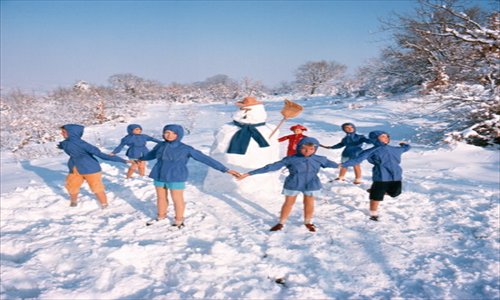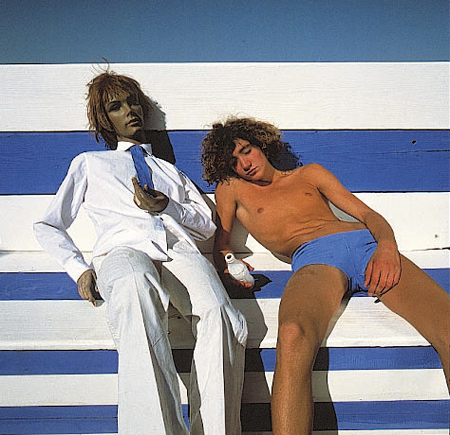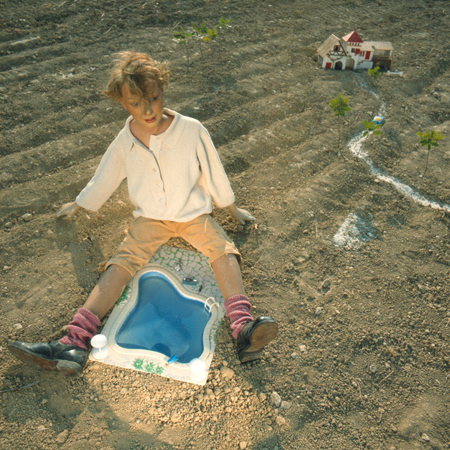HOME >> ARTS, METRO BEIJING
Sepia Dreams
By Shen Lili Source:Global Times Published: 2012-6-10 19:40:02

Bernard Faucon weaved models, reality and dreams into his photographs. Photos: Websites


Bernard Faucon weaved models, reality and dreams into his photographs. Photos: Websites

For the first time ever, he is bringing his "dreams" to China. From June 2 to September 15, Bernard Faucon's solo exhibition, True Fiction, is being held at the recently created art gallery, Yuan Space. About 60 masterpieces covering his four major series of works, "Les GrandesVacances," "évolution probable du temps," "Les chambres d'amour" and "Les chambresd'or," will be presented and Chinese audiences will finally have the chance to experience his surreal creations.
Faucon was born in 1950. He studied philosophy at the Sorbonne, but his artistic career didn't really begin until 1976 when he hit upon the concept of combining models with real life materials to create the imagery he desired.
He set off on a journey which he started by taking photographs in the room where he spent his childhood, before traveling to churches and the small coastal town in Arles, where Van Gogh lingered for 15 months. He told the Beijing News that "when I arrived at each place, I disposed of those models quickly, took the photo, then packed up and went on my journey to the next destination. Those models and those places remind me my childhood memories."
At first, Faucon's method was not accepted by other photographers. Henri Cartier-Bresson, for example, was one photographer who didn't like Faucon's methodology. Fortunately for Faucon however, audiences disagreed and flocked to his exhibitions.
Faucon's main goal was to recreate his dreams within his lens.
He designed the backdrops in advance, found or built the scenery, acquired the right props, posed the "action figures," and then created images of vibrant color. It is perhaps more accurate to say he "made" pictures rather than took them. Although he wasn't the first to "make" photographs like this, he adopted this method for all his works.
"Faucon's master works were all made more than 30 years ago. He can be regarded as a pioneer of post-modern photography," said Li Shixiong, a photography teacher at Xiamen University. Li expressed gratitude towards the curator of the exhibition for bringing these works to China, saying that that Faucon's "imaginary reality" has historic significance.
Since 1977, Faucon has staged over 400 solo exhibitions, mostly across Western Europe, the US, Japan, India and South Korea. However, the master suspended his photography work in 1995 when his career was at its zenith, and instead became a poet. Perhaps foreseeing how significant digital photography would become, Faucon exited the scene before it was transformed.
Modern photographers have no need of Faucon's sets, models and techniques, because digital cameras and modern software have provided alternatives for aspiring artists wishing to create surreal photographs. This exhibition however, will give audiences insight into how these forms of creativity were nurtured in the days before Photoshop and auto-focus lenses.
Jia Fang, a teacher at the Nanjing University of the Arts believes that the exhibition comes too long after Faucon's heyday. "Faucon's works represent the inspirational origins of many concept photographs, but its novelty is gone," He said. "I went to see his works, thinking about the time when he created them. I admire him very much but that's it. Once concept photographs lose their sense of novelty and freshness, they rapidly fade away," Jia told the Global Times.

Bernard Faucon weaved models, reality and dreams into his photographs. Photos: Websites
French photographer Bernard Faucon is the master when it comes to putting dreams into photographs.For the first time ever, he is bringing his "dreams" to China. From June 2 to September 15, Bernard Faucon's solo exhibition, True Fiction, is being held at the recently created art gallery, Yuan Space. About 60 masterpieces covering his four major series of works, "Les GrandesVacances," "évolution probable du temps," "Les chambres d'amour" and "Les chambresd'or," will be presented and Chinese audiences will finally have the chance to experience his surreal creations.
Faucon was born in 1950. He studied philosophy at the Sorbonne, but his artistic career didn't really begin until 1976 when he hit upon the concept of combining models with real life materials to create the imagery he desired.
He set off on a journey which he started by taking photographs in the room where he spent his childhood, before traveling to churches and the small coastal town in Arles, where Van Gogh lingered for 15 months. He told the Beijing News that "when I arrived at each place, I disposed of those models quickly, took the photo, then packed up and went on my journey to the next destination. Those models and those places remind me my childhood memories."
At first, Faucon's method was not accepted by other photographers. Henri Cartier-Bresson, for example, was one photographer who didn't like Faucon's methodology. Fortunately for Faucon however, audiences disagreed and flocked to his exhibitions.
Faucon's main goal was to recreate his dreams within his lens.
He designed the backdrops in advance, found or built the scenery, acquired the right props, posed the "action figures," and then created images of vibrant color. It is perhaps more accurate to say he "made" pictures rather than took them. Although he wasn't the first to "make" photographs like this, he adopted this method for all his works.
"Faucon's master works were all made more than 30 years ago. He can be regarded as a pioneer of post-modern photography," said Li Shixiong, a photography teacher at Xiamen University. Li expressed gratitude towards the curator of the exhibition for bringing these works to China, saying that that Faucon's "imaginary reality" has historic significance.
Since 1977, Faucon has staged over 400 solo exhibitions, mostly across Western Europe, the US, Japan, India and South Korea. However, the master suspended his photography work in 1995 when his career was at its zenith, and instead became a poet. Perhaps foreseeing how significant digital photography would become, Faucon exited the scene before it was transformed.
Modern photographers have no need of Faucon's sets, models and techniques, because digital cameras and modern software have provided alternatives for aspiring artists wishing to create surreal photographs. This exhibition however, will give audiences insight into how these forms of creativity were nurtured in the days before Photoshop and auto-focus lenses.
Jia Fang, a teacher at the Nanjing University of the Arts believes that the exhibition comes too long after Faucon's heyday. "Faucon's works represent the inspirational origins of many concept photographs, but its novelty is gone," He said. "I went to see his works, thinking about the time when he created them. I admire him very much but that's it. Once concept photographs lose their sense of novelty and freshness, they rapidly fade away," Jia told the Global Times.
Where: 20th Floor, Jiaming Center, 27 Northeast Third Ring Road
When: Until September 16
Admission: Free
Contact: 5775-5070
Posted in: ARTS, Metro Beijing